1993 DODGE TRUCK transmission oil
[x] Cancel search: transmission oilPage 1265 of 1502
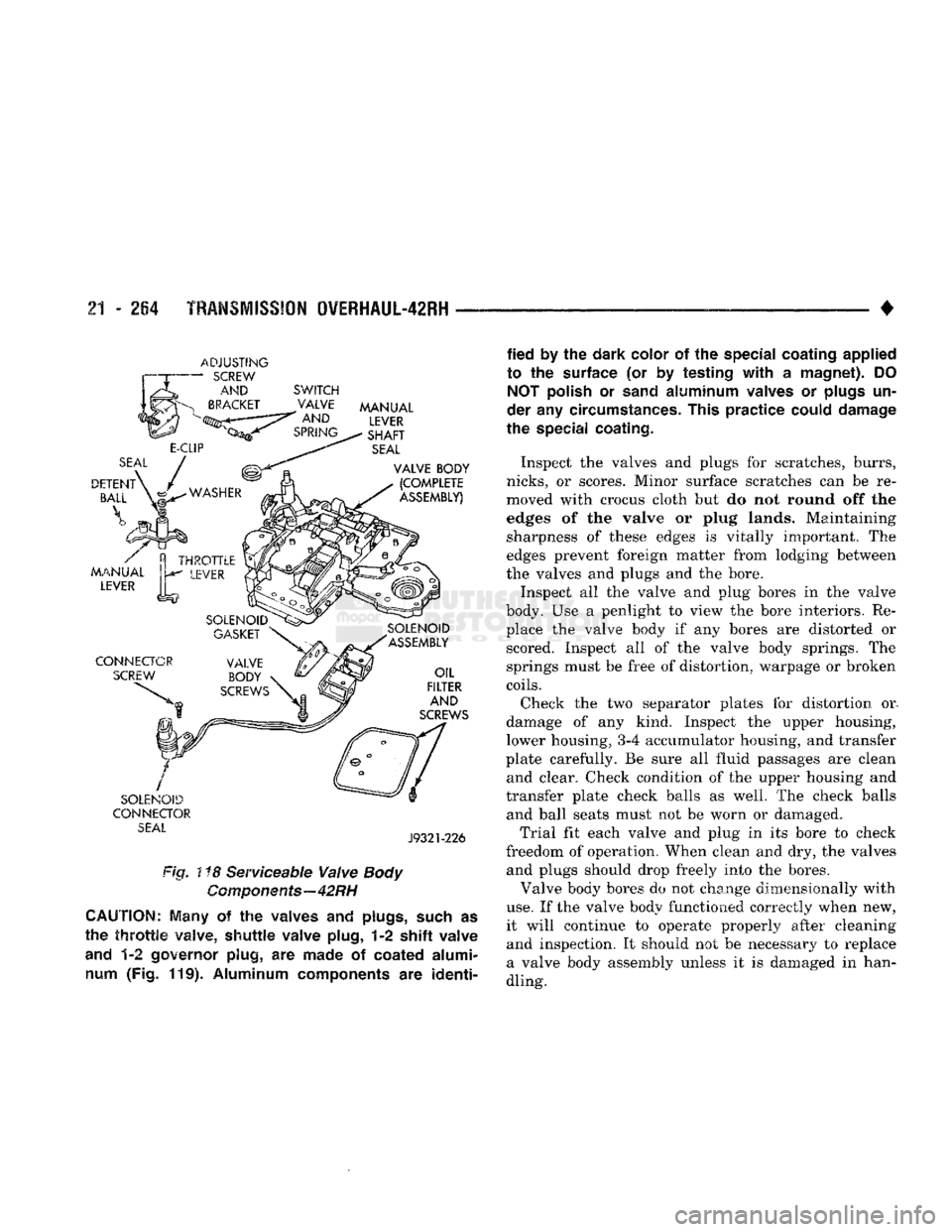
21
- 264
TRANSMISSION QVERHAUL-42RH
ADJUSTING
-
SCREW
AND
SWITCH
CONNECTOR
SEAL
J9321-226
Fig. ! *8 Serviceable Valve
Body
Components—42RH
CAUTION;
Many
of the
waives
and
plugs,
such
as
the
throttle
valve,
shuttle
valve plug,
1-2 shift
valve
and
1-2
governor plug,
are
made
of
coated alumi num
(Fig. 119).
Aluminum components
are
identi
fied
by the
dark color
of the
special coating applied
to
the
surface
(or by
testing
with
a
magnet).
DO
NOT
polish
or
sand
aluminum valves
or
plugs
un
der
any
circumstances. This practice could damage
the special coating.
Inspect the valves and plugs for scratches, burrs,
nicks,
or scores. Minor surface scratches can be re
moved with crocus cloth but do not round off the
edges of the valve or plug lands. Maintaining sharpness of these edges is vitally important. The
edges prevent foreign matter from lodging between
the valves and plugs and the bore.
Inspect all the valve and plug bores in the valve
body. Use a penlight to view the bore interiors. Re place the valve body if any bores are distorted or scored. Inspect all of the valve body springs. The
springs must be free of distortion, warpage or broken
coils.
Check the two separator plates for distortion or.
damage of any kind. Inspect the upper housing,
lower housing,
3-4
accumulator housing, and transfer
plate carefully. Be sure all fluid passages are clean and clear. Check condition of the upper housing and
transfer plate check balls as well. The check balls and ball seats must not be worn or damaged.
Trial fit each valve and plug in its bore to check
freedom of operation. When clean and dry, the valves and plugs should drop freely into the bores.
Valve body bores do not change dimensionally with
use.
If the valve body functioned correctly when new,
it will continue to operate properly after cleaning and inspection. It should not be necessary to replace
a valve body assembly unless it is damaged in han
dling.
Page 1270 of 1502
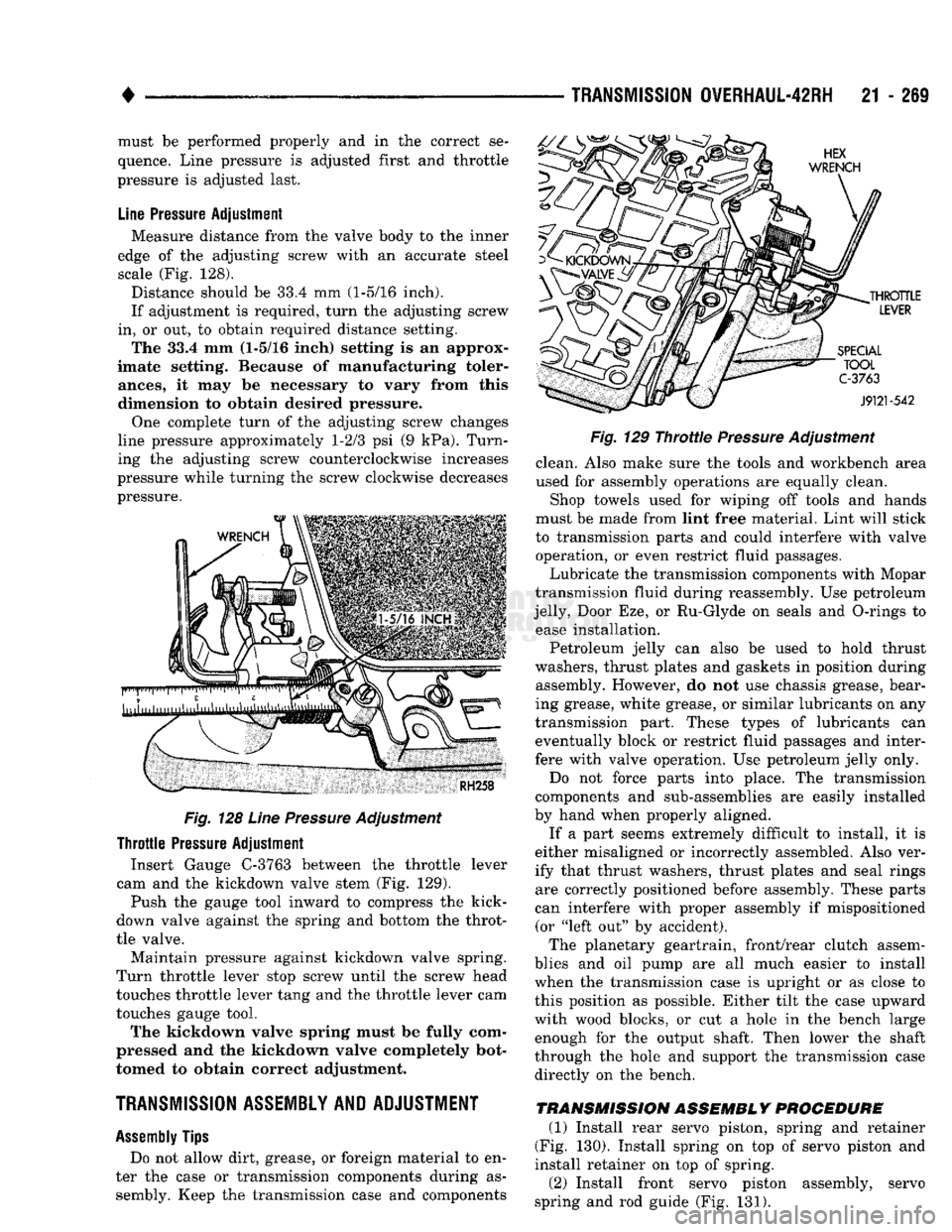
•
TRANSMISSION
OVERHAUL-42RH
21 - 269 must be performed properly and in the correct se
quence. Line pressure is adjusted first and throttle
pressure is adjusted last.
Line
Pressure
Adjustment
Measure distance from the valve body to the inner
edge of the adjusting screw with an accurate steel
scale (Fig. 128).
Distance should be 33.4 mm (1-5/16 inch).
If adjustment is required, turn the adjusting screw
in, or out, to obtain required distance setting. The 33.4 mm (1-5/16 inch) setting is an approx
imate setting. Because of manufacturing toler
ances,
it may be necessary to vary from this
dimension to obtain desired pressure.
One complete turn of the adjusting screw changes
line pressure approximately 1-2/3 psi (9 kPa). Turn
ing the adjusting screw counterclockwise increases
pressure while turning the screw clockwise decreases
pressure.
Fig.
128
Line
Pressure
Adjustment
Throttle
Pressure
Adjustment Insert Gauge C-3763 between the throttle lever
cam and the kickdown valve stem (Fig. 129).
Push the gauge tool inward to compress the kick-
down valve against the spring and bottom the throt
tle valve.
Maintain pressure against kickdown valve spring.
Turn throttle lever stop screw until the screw head
touches throttle lever tang and the throttle lever cam
touches gauge tool.
The kickdown valve spring must be fully com
pressed and the kickdown valve completely bot
tomed to obtain correct adjustment.
TRANSMISSION ASSEMBLY AND ADJUSTMENT
Assembly
Tips
Do not allow dirt, grease, or foreign material to en
ter the case or transmission components during as sembly. Keep the transmission case and components
Fig.
129
Throttie
Pressure
Adjustment
clean. Also make sure the tools and workbench area
used for assembly operations are equally clean.
Shop towels used for wiping off tools and hands
must be made from lint free material. Lint will stick
to transmission parts and could interfere with valve operation, or even restrict fluid passages.
Lubricate the transmission components with Mopar
transmission fluid during reassembly. Use petroleum
jelly, Door Eze, or Ru-Glyde on seals and O-rings to ease installation.
Petroleum jelly can also be used to hold thrust
washers, thrust plates and gaskets in position during assembly. However, do not use chassis grease, bear
ing grease, white grease, or similar lubricants on any
transmission part. These types of lubricants can eventually block or restrict fluid passages and inter
fere with valve operation. Use petroleum jelly only.
Do not force parts into place. The transmission
components and sub-assemblies are easily installed
by hand when properly aligned.
If a part seems extremely difficult to install, it is
either misaligned or incorrectly assembled. Also ver
ify that thrust washers, thrust plates and seal rings are correctly positioned before assembly. These parts
can interfere with proper assembly if mispositioned (or "left out" by accident).
The planetary geartrain, front/rear clutch assem
blies and oil pump are all much easier to install
when the transmission case is upright or as close to
this position as possible. Either tilt the case upward
with wood blocks, or cut a hole in the bench large enough for the output shaft. Then lower the shaft
through the hole and support the transmission case
directly on the bench.
TRANSMISSION ASSEMBLY PROCEDURE
(1) Install rear servo piston, spring and retainer
(Fig. 130). Install spring on top of servo piston and
install retainer on top of spring.
(2) Install front servo piston assembly, servo
spring and rod guide (Fig. 131).
Page 1274 of 1502
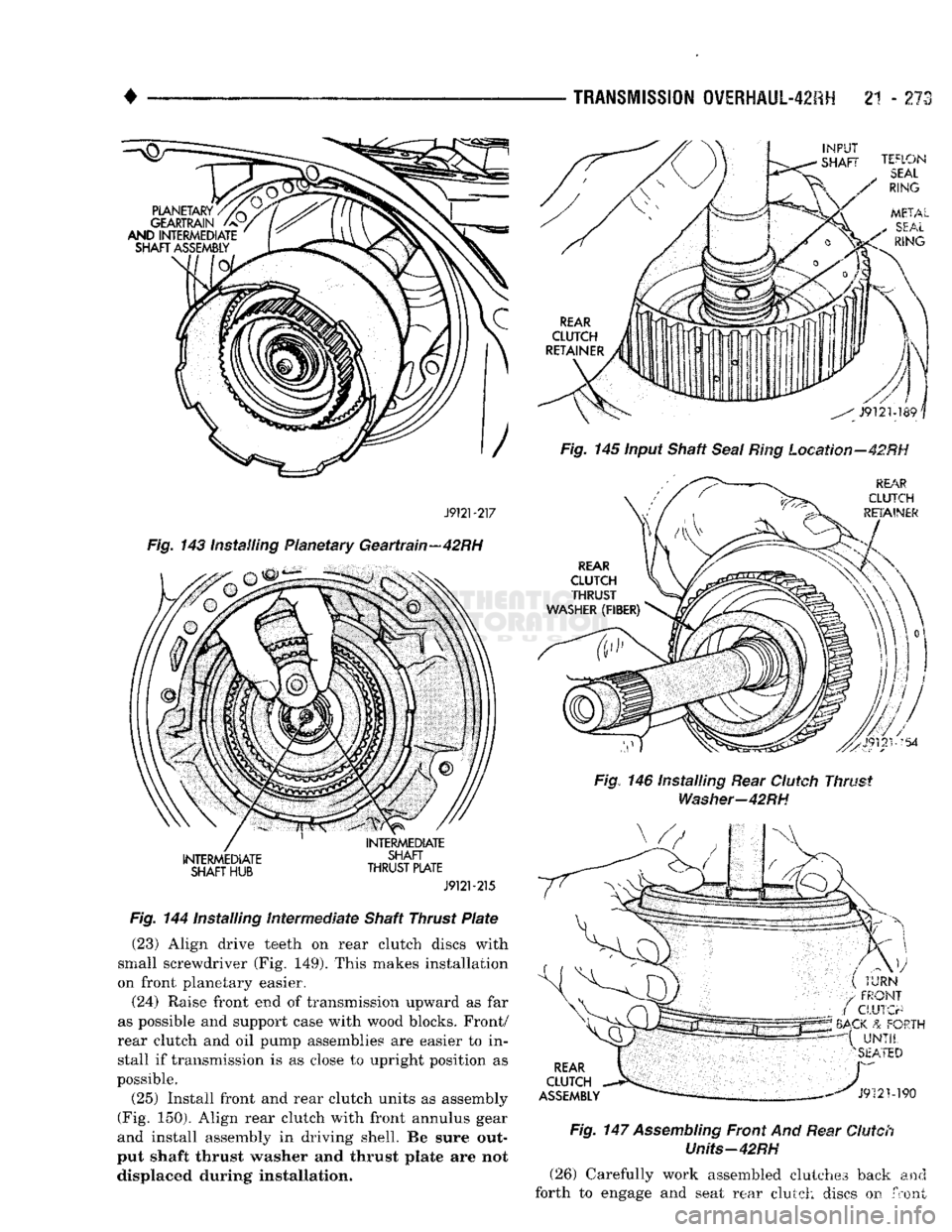
•
TRANSMISSION
OVERHAUL-42RH
2"! - 273
J9121-217
Fig.
143 installing Planetary Geartrain—42RH
INTERMEDIATE
SHAFT
HUB
INTERMEDIATE
SHAFT
THRUST
PLATE
J9121-215
Fig.
144 installing
intermediate
Shaft Thrust
Plate
(23) Align drive teeth on rear clutch discs with
small screwdriver (Fig. 149). This makes installation
on front planetary easier.
(24) Raise front end of transmission upward as far
as possible and support case with wood blocks. Front/
rear clutch and oil pump assemblies are easier to in
stall if transmission is as close to upright position as
possible.
(25) Install front and rear clutch units as assembly
(Fig. 150). Align rear clutch with front annulus gear
and install assembly in driving shell. Re sure out
put shaft thrust washer and thrust plate are not displaced during installation.
INPUT
SHAFT
TEFLON
SEAL
/
RING
METAL
SEAL
RING
Fig.
145 Input Shaft
Seal
Ring
Location-42RH REAR
CLU1CH
^ETA'Mnk
Fig,
146 Installing Rear
Clutch
Thrust
Washer-42RH
REAR
CLUTCH
ASSEMBLY
i
i
JfiN
"
FRONT
CLIPCr
BACK & FO-TH { UNTIL i
SEATED
J9121-190
Fig.
147
Assembling
Front And Rear
Clutch
Units-42RH
(26) Carefully work assembled clutches back and
forth to engage and seat rear clutch discs on
front
Page 1275 of 1502
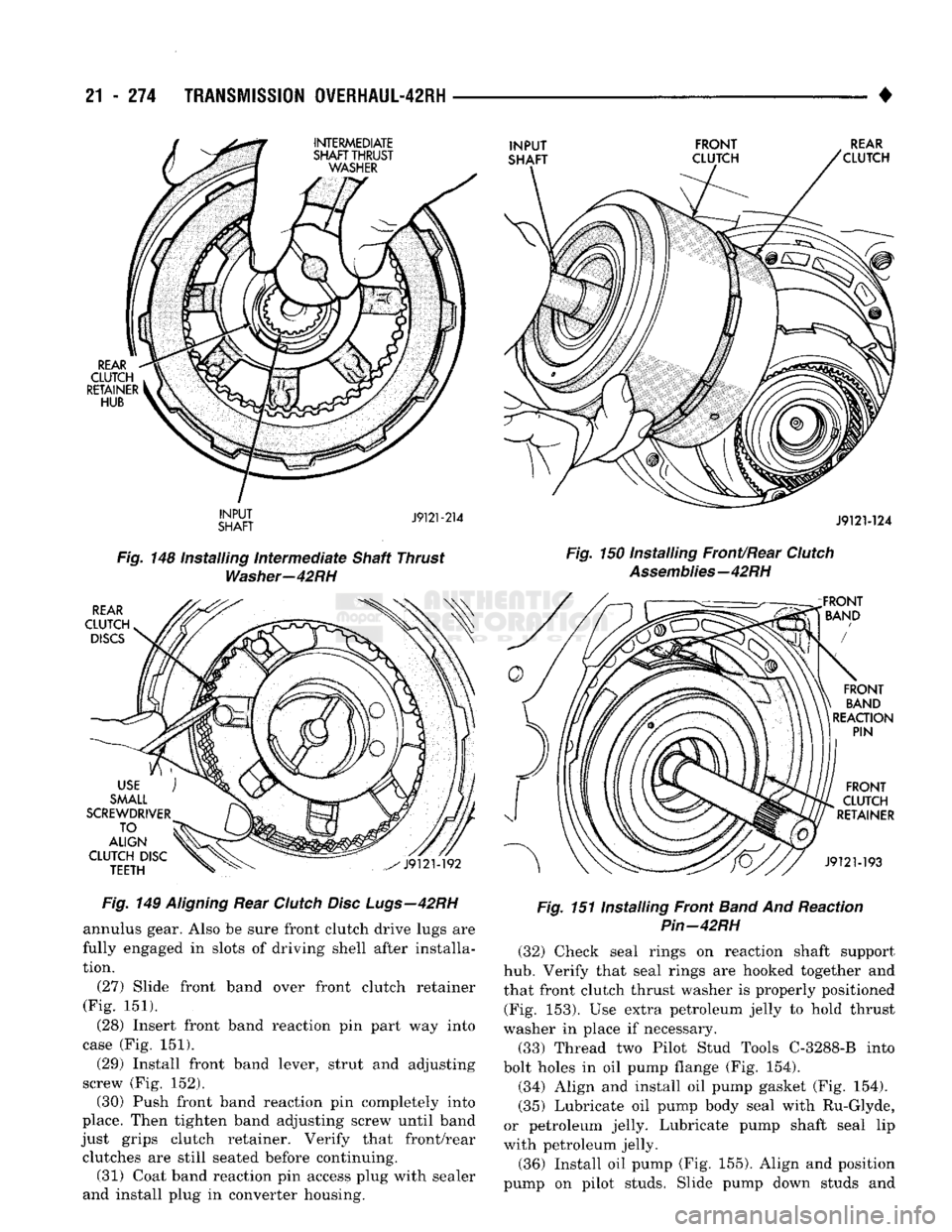
21
- 274
TRANSMISSION
0WERHAUL-42RH
INTERMEDIATE
SHAFT THRUST
WASHER
INPUT
SHAFT FRONT
CLUTCH
REAR
'CLUTCH
REAR
CLUTCH
RETAINER
HUB
INPUT
SHAFT
J9121-214
J9121-124
Fig.
148 Installing
Intermediate
Shaft Thrust
Washer-42RH
Fig.
150 Installing Front/Rear
Clutch
Assemblies—42RH
REAR
CLUTCH
DISCS
USE
SMALL
SCREWDRIVER
TO
ALIGN
CLUTCH DISC TEETH
^J9121-192
:FRONT
BAND
FRONT
BAND
REACTION PIN
FRONT
CLUTCH
RETAINER
J912M93
Fig.
149
Aligning
Rear
Clutch
Disc Lugs—42RH
annulus gear. Also be sure front clutch drive lugs are
fully engaged in slots of driving shell after installa
tion.
(27) Slide front band over front clutch retainer
(Fig. 151).
(28) Insert front band reaction pin part way into
case (Fig. 151).
(29) Install front band lever, strut and adjusting
screw (Fig. 152).
(30) Push front band reaction pin completely into
place. Then tighten band adjusting screw until band
just grips clutch retainer. Verify that front/rear clutches are still seated before continuing. (31) Coat band reaction pin access plug with sealer
and install plug in converter housing.
Fig.
151 Installing Front
Band
And Reaction
Pin-42RH (32) Check seal rings on reaction shaft support
hub.
Verify that seal rings are hooked together and that front clutch thrust washer is properly positioned (Fig. 153). Use extra petroleum jelly to hold thrust
washer in place if necessary.
(33) Thread two Pilot Stud Tools C-3288-B into
bolt holes in oil pump flange (Fig. 154). (34) Align and install oil pump gasket (Fig. 154).
(35) Lubricate oil pump body seal with Ru-Glyde,
or petroleum jelly. Lubricate pump shaft seal lip
with petroleum jelly.
(36) Install oil pump (Fig. 155). Align and position
pump on pilot studs. Slide pump down studs and
Page 1276 of 1502
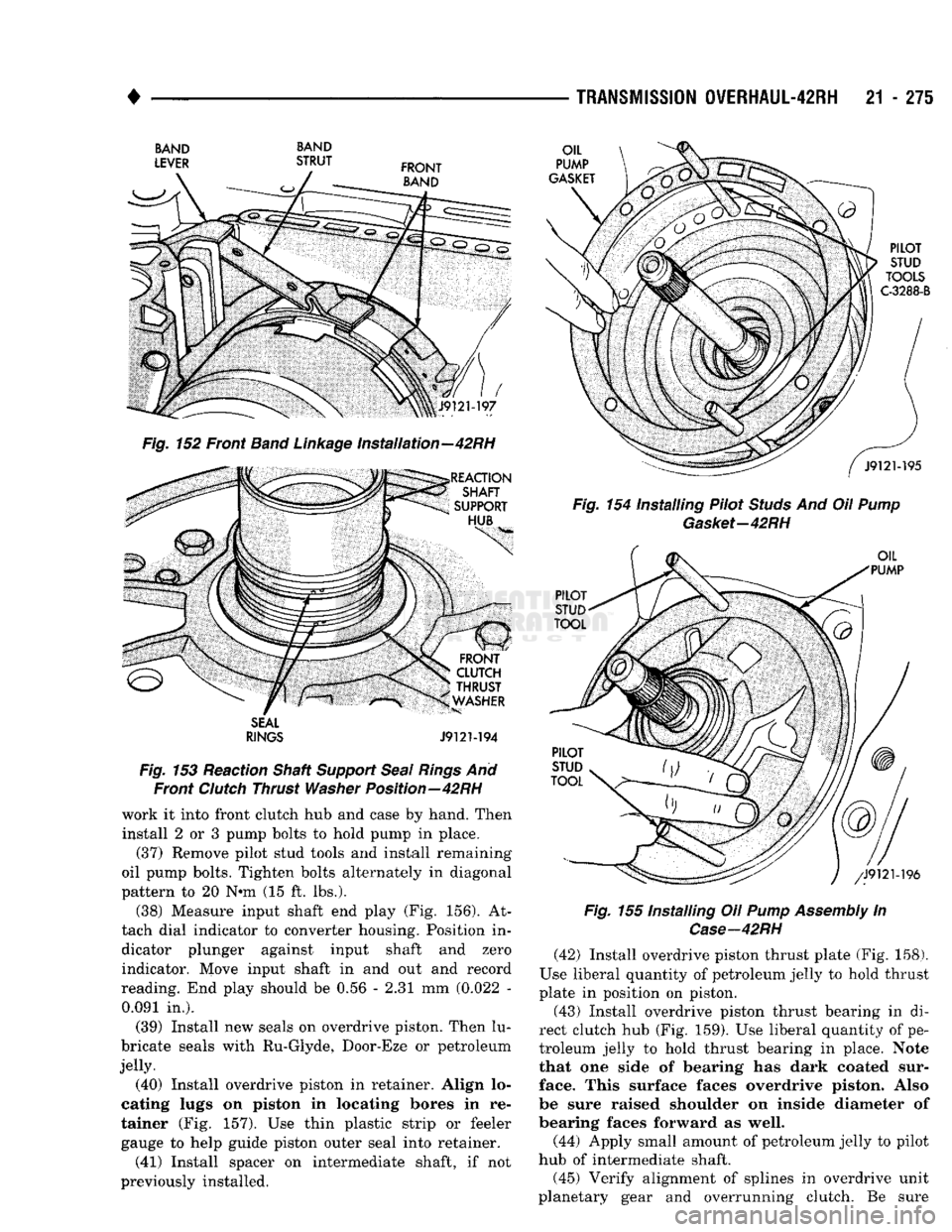
•
BAND BAND
Fig.
152 Front
Band
Linkage
Installation—42RH
SEAL
RINGS
J9121-194
Fig.
153 Reaction Shaft
Support
Seal
Rings
And Front
Clutch
Thrust
Washer
Position—42RH
work it into front clutch hub and case by hand. Then
install 2 or 3 pump bolts to hold pump in place. (37) Remove pilot stud tools arid install remaining
oil pump bolts. Tighten bolts alternately in diagonal
pattern to 20 N*m (15 ft. lbs.).
(38) Measure input shaft end play (Fig. 156). At
tach dial indicator to converter housing. Position in dicator plunger against input shaft and zero indicator. Move input shaft in and out and record
reading. End play should be 0.56 - 2.31 mm (0.022 - 0.091 in.).
(39) Install new seals on overdrive piston. Then lu
bricate seals with Ru-Glyde, Door-Eze or petroleum
jelly. (40) Install overdrive piston in retainer. Align lo
cating lugs on piston in locating bores in re
tainer (Fig. 157). Use thin plastic strip or feeler gauge to help guide piston outer seal into retainer. (41) Install spacer on intermediate shaft, if not
previously installed.
TRANSMISSION
0VERHAUL-42RH
21 - 275
Fig.
154 Installing Pilot
Studs
And Oil
Pump
Gasket-42RH
Fig.
155 Installing Oil
Pump
Assembly
In
Case—42RH
(42) Install overdrive piston thrust plate (Fig. 158).
Use liberal quantity of petroleum jelly to hold thrust
plate in position on piston. (43) Install overdrive piston thrust bearing in di
rect clutch hub (Fig. 159). Use liberal quantity of pe
troleum jelly to hold thrust bearing in place. Note
that one side of bearing has dark coated sur
face. This surface faces overdrive piston. Also
be sure raised shoulder on inside diameter of
bearing faces forward as well.
(44) Apply small amount of petroleum jelly to pilot
hub of intermediate shaft.
(45) Verify alignment of splines in overdrive unit
planetary gear and overrunning clutch. Be sure
Page 1278 of 1502
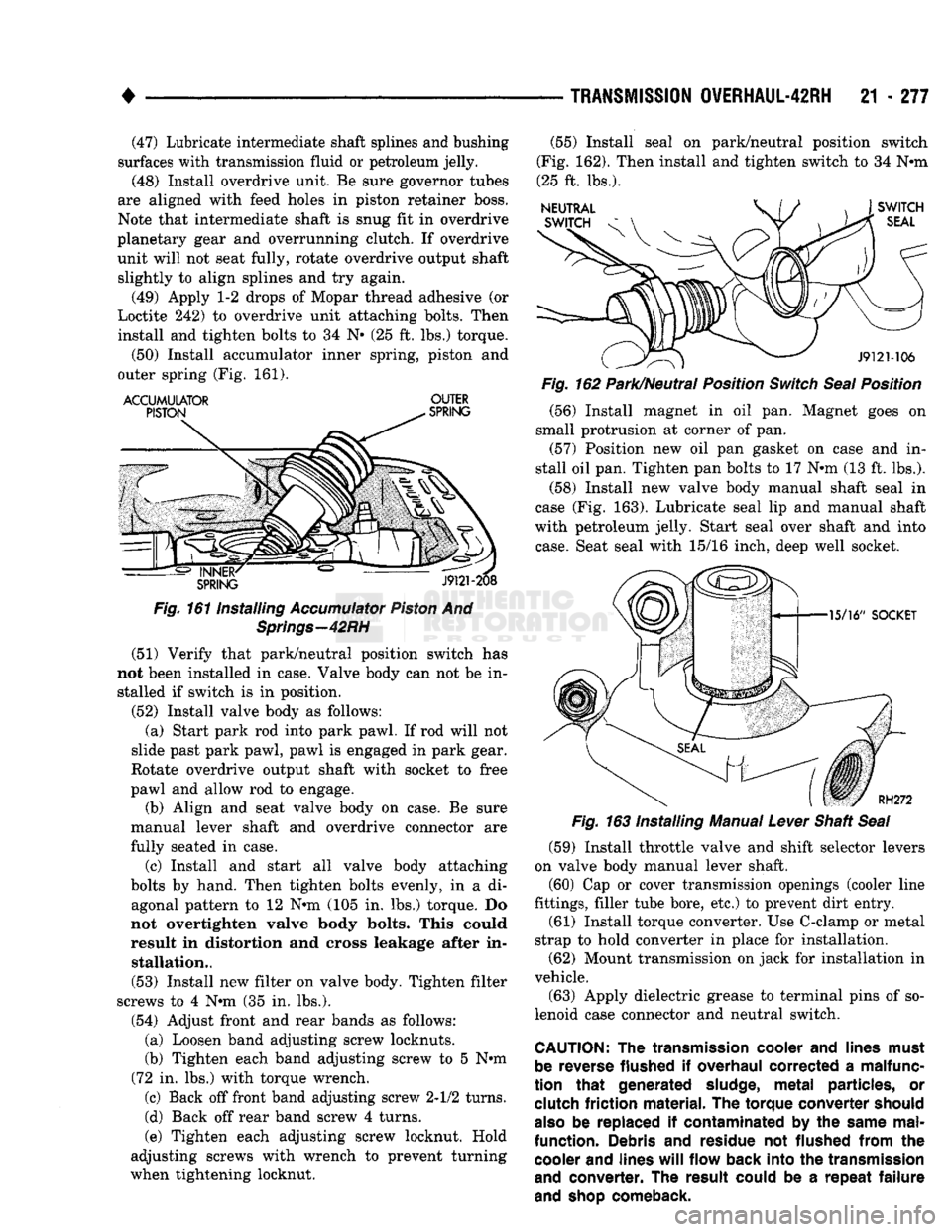
•
TRANSMISSION
OVERHAUL-42RH
21 - 277 (47) Lubricate intermediate shaft splines and bushing
surfaces with transmission fluid or petroleum jelly.
(48) Install overdrive unit. Be sure governor tubes
are aligned with feed holes in piston retainer boss. Note that intermediate shaft is snug fit in overdrive
planetary gear and overrunning clutch. If overdrive unit will not seat fully, rotate overdrive output shaft slightly to align splines and try again.
(49) Apply 1-2 drops of Mopar thread adhesive (or
Loctite 242) to overdrive unit attaching bolts. Then install and tighten bolts to 34 N« (25 ft. lbs.) torque.
(50) Install accumulator inner spring, piston and
outer spring (Fig. 161).
ACCUMULATOR
OUTER
Fig.
161 Installing
Accumulator
Piston
And
Springs—42RH
(51) Verify that park/neutral position switch has
not been installed in case. Valve body can not be in stalled if switch is in position.
(52) Install valve body as follows: (a) Start park rod into park pawl. If rod will not
slide past park pawl, pawl is engaged in park gear.
Rotate overdrive output shaft with socket to free
pawl and allow rod to engage.
(b) Align and seat valve body on case. Be sure
manual lever shaft and overdrive connector are
fully seated in case.
(c) Install and start all valve body attaching
bolts by hand. Then tighten bolts evenly, in a di agonal pattern to 12 N»m (105 in. lbs.) torque. Do
not overtighten valve body bolts. This could
result in distortion and cross leakage after in stallation..
(53) Install new filter on valve body. Tighten filter
screws to 4 N*m (35 in. lbs.).
(54) Adjust front and rear bands as follows: (a) Loosen band adjusting screw locknuts.
(b) Tighten each band adjusting screw to 5 Nnn
(72 in. lbs.) with torque wrench.
(c) Back off front band adjusting screw 2-1/2 turns.
(d) Back off rear band screw 4 turns.
(e) Tighten each adjusting screw locknut. Hold
adjusting screws with wrench to prevent turning
when tightening locknut. (55) Install seal on park/neutral position switch
(Fig. 162). Then install and tighten switch to 34 N«m
(25 ft. lbs.).
Fig.
162 Park/Neutral Position
Switch
Seal
Position
(56) Install magnet in oil pan. Magnet goes on
small protrusion at corner of pan. (57) Position new oil pan gasket on case and in
stall oil pan. Tighten pan bolts to 17 N*m (13 ft. lbs.).
(58) Install new valve body manual shaft seal in
case (Fig. 163). Lubricate seal lip and manual shaft
with petroleum jelly. Start seal over shaft and into
case.
Seat seal with 15/16 inch, deep well socket.
(59) Install throttle valve and shift selector levers
on valve body manual lever shaft. (60) Cap or cover transmission openings (cooler line
fittings, filler tube bore, etc.) to prevent dirt entry.
(61) Install torque converter. Use C-clamp or metal
strap to hold converter in place for installation. (62) Mount transmission on jack for installation in
vehicle.
(63) Apply dielectric grease to terminal pins of so
lenoid case connector and neutral switch.
CAUTION:
The
transmission
cooler
and
lines
must
be
reverse
flushed
if
overhaul
corrected
a
malfunc
tion
that
generated
sludge,
metal
particles,
or
clutch
friction
material.
The
torque
converter
should
also
be replaced if
contaminated
by the
same
mal
function.
Debris and
residue
not
flushed
from
the
cooler
and
lines
will
flow
back
into
the
transmission
and
converter.
The
result
could
be a
repeat
failure
and
shop
comeback.
Page 1279 of 1502
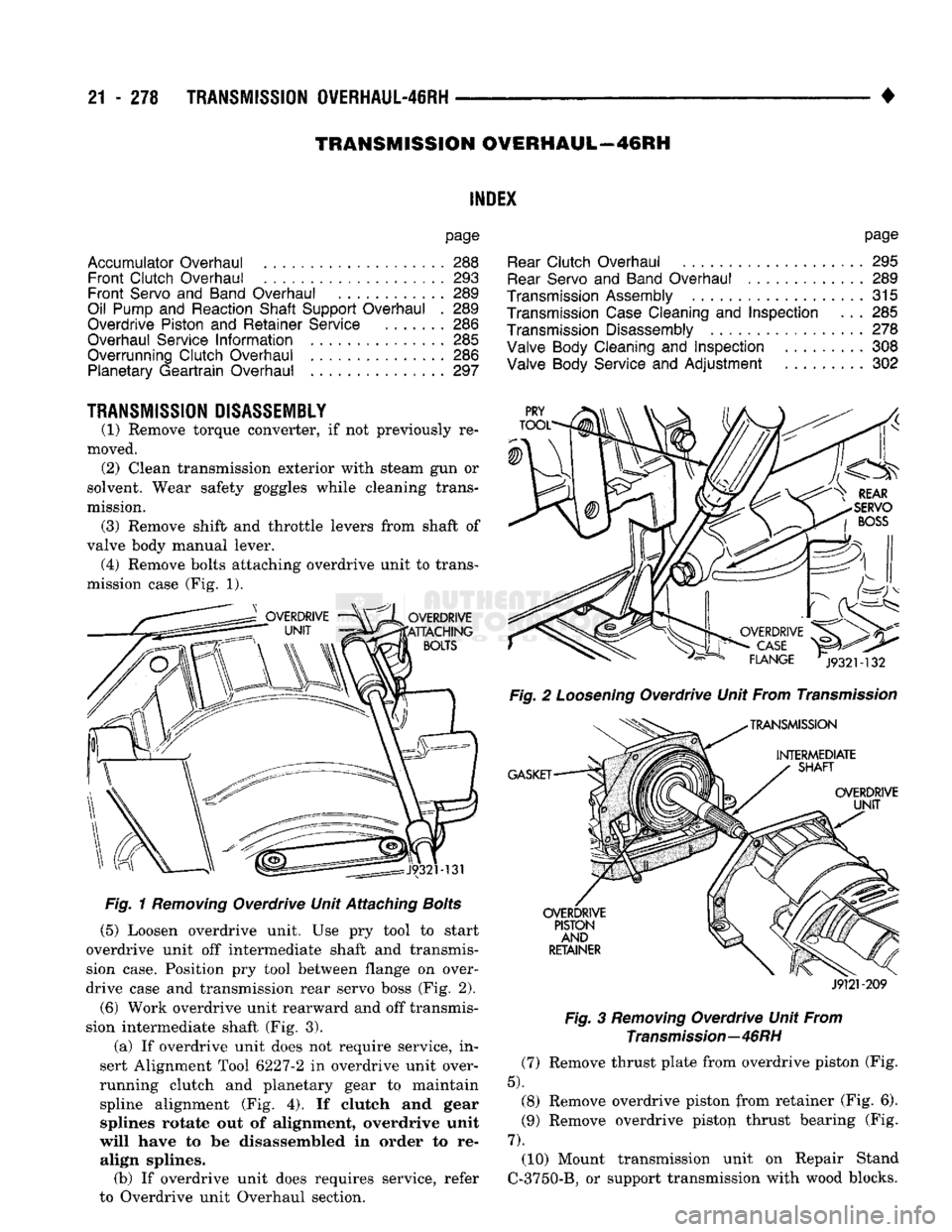
21
- 278
TRANSMISSION
0VERHAUL-4IRH
•
TRANSMISSION OWERHAUL-46RH
INDEX
page
Accumulator Overhaul
288
Front Clutch Overhaul
293
Front Servo
and
Band Overhaul
............
289
Oil Pump
and
Reaction Shaft Support Overhaul
. 289
Overdrive Piston
and
Retainer Service
286
Overhaul Service
Information
285
Overrunning Clutch Overhaul
286
Planetary Geartrain Overhaul
...............
297
TRANSMISSION
DISASSEMBLY
(1) Remove torque converter,
if not
previously
re
moved. (2) Clean transmission exterior with steam
gun or
solvent. Wear safety goggles while cleaning trans
mission. (3) Remove shift
and
throttle levers from shaft
of
valve body manual lever. (4) Remove bolts attaching overdrive unit
to
trans
mission case
(Fig. 1).
Fig.
1
Removing
Overdrive Unit Attaching
Bolts
(5) Loosen overdrive unit.
Use pry
tool
to
start
overdrive unit
off
intermediate shaft
and
transmis
sion case. Position
pry
tool between flange
on
over
drive case
and
transmission rear servo boss
(Fig. 2).
(6) Work overdrive unit rearward
and off
transmis
sion intermediate shaft
(Fig. 3).
(a)
If
overdrive unit does
not
require service,
in
sert Alignment Tool 6227-2
in
overdrive unit over
running clutch
and
planetary gear
to
maintain spline alignment
(Fig. 4). If
clutch
and
gear splines rotate
out of
alignment, overdrive unit
will have
to be
disassembled
in
order
to re
align splines. (b)
If
overdrive unit does requires service, refer
to Overdrive unit Overhaul section.
page
Rear
Clutch Overhaul
295
Rear
Servo
and
Band Overhaul
. 289
Transmission
Assembly
...................
315
Transmission
Case
Cleaning
and
Inspection
. . . 285
Transmission
Disassembly
278
Valve
Body Cleaning
and
Inspection
308
Valve
Body Service
and
Adjustment
. 302
Fig.
2
Loosening
Overdrive Unit From
Transmission
J9121-209
Fig.
3
Removing
Overdrive Unit From
Transmission—46RH
(7) Remove thrust plate from overdrive piston
(Fig.
5). (8)
Remove overdrive piston from retainer
(Fig. 6).
(9)
Remove overdrive pistop thrust bearing
(Fig.
7).
(10) Mount transmission unit
on
Repair Stand
C-3750-B,
or
support transmission with wood blocks.
Page 1280 of 1502
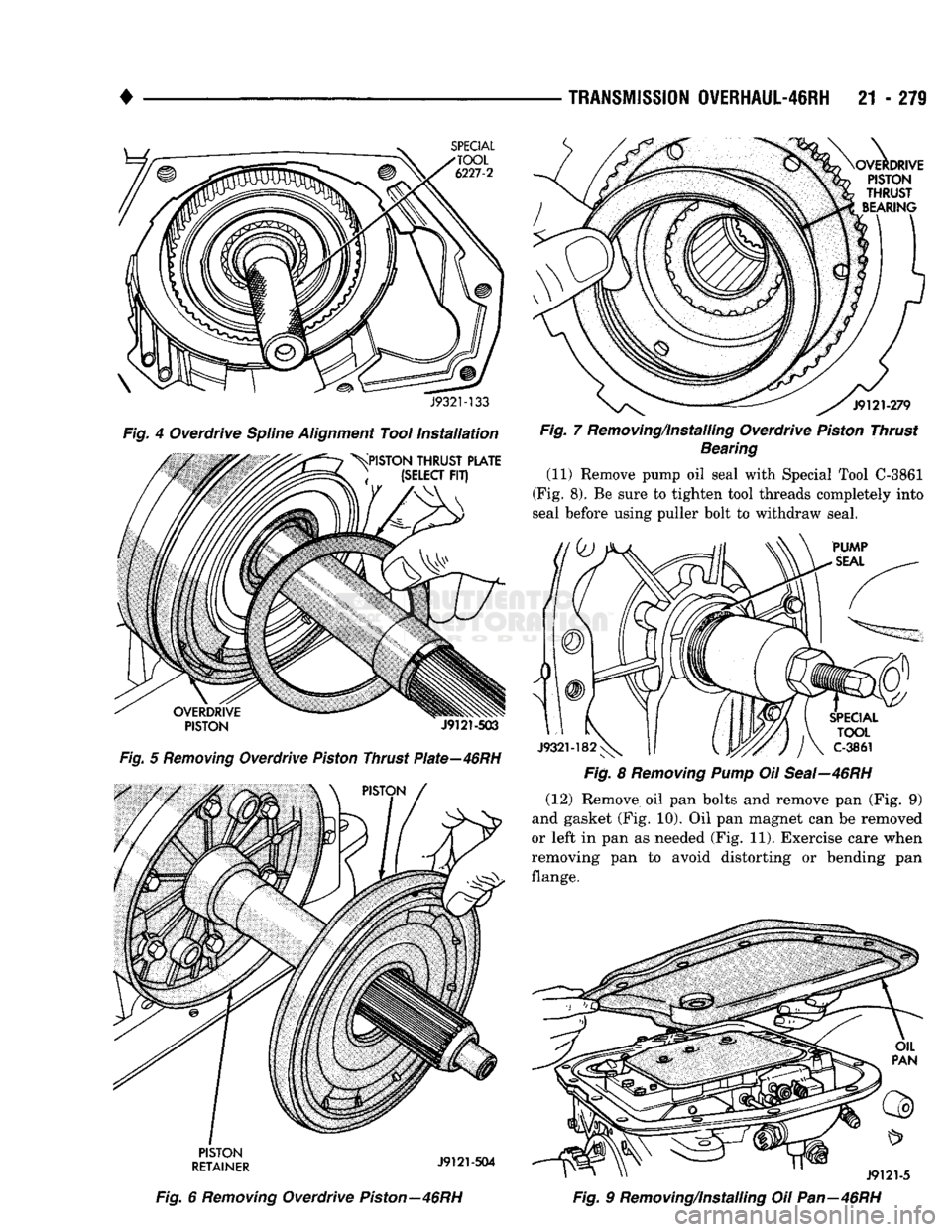
TRANSMISSION
OVERHAUL-46RH
21 - 279
SPECIAL
J9321-133
Fig.
4 Overdrive Spline Alignment Tool
Installation
>sPISTON THRUST PLATE (SELECT FIT)
W
OVERDRIVE PISTON
J9121-503
Fig.
5
Removing
Overdrive
Piston
Thrust
Plate—46RH
PISTON OVERDRIVE
PISTON
THRUST
BEARING
\
J9121-279
Fig.
7 Removing/Installing Overdrive Piston Thrust
Bearing
(11) Remove pump oil seal with Special Tool C-3861
(Fig. 8). Be sure to tighten tool threads completely into
seal before using puller bolt to withdraw seal.
J9321-182\>s
Fig.
8
Removing
Pump
Oil Seal—46RH (12) Remove oil pan bolts and remove pan (Fig. 9)
and gasket (Fig. 10). Oil pan magnet can be removed
or left in pan as needed (Fig. 11). Exercise care when
removing pan to avoid distorting or bending pan
flange.
PISTON
RETAINER
Fig.
6
Removing
Overdrive Piston—46RH
J9121-5
Fig.
9 Removing/Installing Oil Pan—46RH